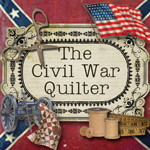If you haven't yet read my previous post about the Indian image on five quilts found via the Internet over the last several months, click
here for background before reading this current update.
Barbara Brackman responded to my email this morning by sending me a link to an image that is so similar to the image on two of the five quilts that I exclaimed in delight! See the iron image below sold at a Cowan Auction in 2009.
You can see it at Cowan Auctions here:
http://www.cowanauctions.com/auctions/item.aspx?ItemId=68061
According to the auction details, it is late 19th century, sheet iron, with traces of green paint and was originally mounted on the
Red Men's Lodge in Tucson, Ohio. It stands 22" high x 18" wide.
Now look at some of the quilt blocks again:
So who are The Red Men? This was a group I had never heard of before. But a little googling came up with a lot of info!
Turns out it is a fraternal order that traces its origins back to 1765 and is "descended from the Sons of Liberty. These patriots concealed their identities and worked 'underground' to help establish freedom and liberty in the early Colonies. They patterned themselves after the great Iroquois Confederacy and its democratic governing body. Their system, with elected representatives to govern tribal councils, had been in existence for several centuries."
After the War of 1812 the name was changed to the Society of Red Men and in 1834 to the Improved Order of Red Men. They kept the customs and terminology of Native Americans as a basic part of the fraternity. The Improved Order of Red Men (IORM) is similar in many ways to other major fraternal organizations in the United States.
Here are three sources with some history. Click on any one of the three links and you will learn a great deal more. One is from
Heilwood, Pennsylvania. One from
Arizona. The other from
California. Apparently, there are Red Men Lodges all over the country.
From the California Red Man website in Mill Valley:
Improved Order of Red Men - Background, History, Ritual and Emblems
The Improved Order of Red Men was founded in Baltimore in 1834 as a fraternal, social, insurance and political society in the United States. The first tribe was Logan Tribe No. 1 in Baltimore, MD. However, the IORM claims, that it is a lineal descendent of earlier patriotic organizations - the Sons of Liberty, Tammany Societies or Columbian Order, and the Society of Red Men.
In c. 1766, an association of patriots in the United States adopted the name the "Sons of Liberty" following British Member of Parliament Isaac Barre calling the agitators in the colonies by that name. The Son's of Liberty may have formed originally as an association of protesters against the Stamp Act. Its best known exploit was the Boston Tea Party, during which members of the Sons of Liberty (many of whom were Freemasons), disguised as Mohawk Indians, emptied the contents of three hundred and forty-two chests of tea off British ships at Griffin's Wharf on December 16, 1773.
In 1771, the Sons of Liberty at Annapolis, MD had changed their name to the Saint Tamina Society, apparently to ridicule other existing associations that had adopted the patronage of some saint of European extraction, such as the Saint George's Society, Saint Andrew's Society, and Saint David's Society, all of which were loyal to the British Crown." Saint Tamina" was undoubtedly American.
Tamanend was a seventeenth century chief of the Lenni-Lenape tribe of the Delaware. He was credited with being endowed with special abilities to communicate with the Great Spirit. In 1682, Tamanend, sachem ("counselor of the people") and chief, welcomed William Penn to America and signed with him the Treaty of Shakamaxon. The Tammany Society took its name from this celebrated chief who was admired and beloved by both Indians and Colonists. Tamanend acquired the sobriquet, "Saint Tammany".
The other three quilts resemble the Mayan figure more in my opinion that I showed you in my previous post, but my guess is that they too may have been created as a result of association with members of a Red Men Lodge.
We will probably never know for sure but do notice that the headdress on each of the five quilts contains five prongs, i.e. feathers.
Again, if you spot any more quilts in this pattern, please let me know.
KarenQuilt









































